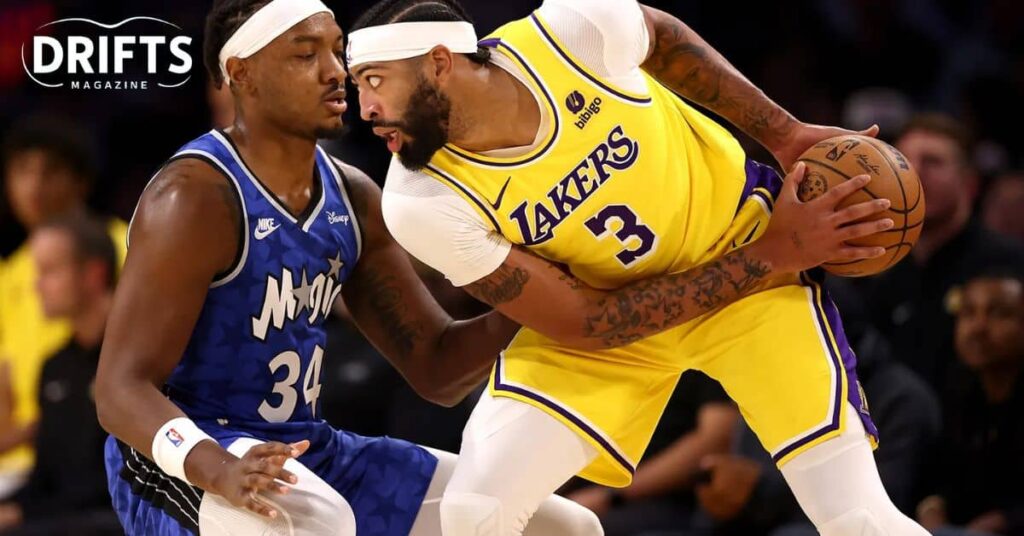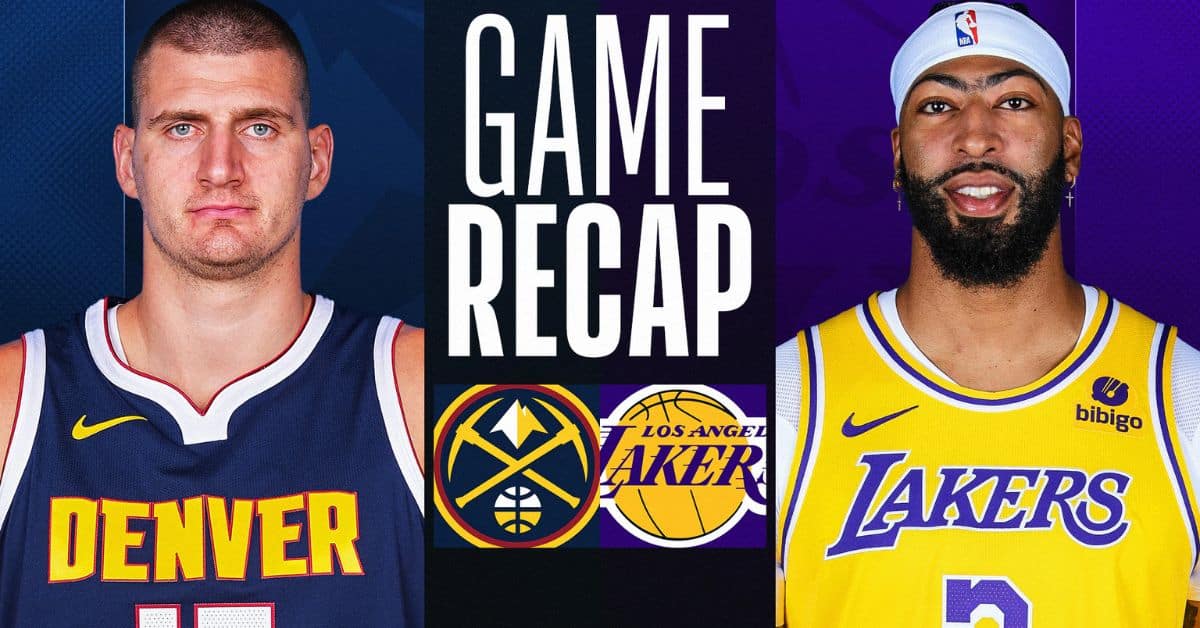The Denver Chunks versus Lakers matchup is a high-profile NBA competition including two Western Gathering forces to be reckoned with. It frequently grandstands headliners like Nikola Jokic and LeBron James, conveying extraordinary b-ball activity and key interactivity.
At the point when the Denver Pieces go head to head against the Lakers, it’s something beyond a game – it’s a factual confrontation. From Jokic’s triple-twofold danger to LeBron’s overall splendor, each play recounts to a story in numbers. Plunge into our itemized examination and find how the details uncover the genuine account of this awe-inspiring NBA conflict.
The NBA end of the season games continuously bring high-stakes ball, however when the Denver Pieces go head to head against the Los Angeles Lakers, a display spellbinds fans around the world. This examination digs into the player measurements from their new matchup, offering experiences into the exhibitions that formed the game’s result.
Nikola Jokic: A Triple-Double Machine
Nikola Jokic, the Nuggets’ centerpiece, once again demonstrated why he’s considered one of the best players in the league. His stat line for the game was nothing short of impressive:
- Points: 32
- Rebounds: 15
- Assists: 13
- Blocks: 2
- Steals: 1
Jokic’s ability to impact every facet of the game was on full display. His vision on the court led to several highlight-reel passes, while his scoring touch kept the Lakers’ defense on their toes throughout the match.
Efficiency From the Field
Jokic’s shooting efficiency was particularly noteworthy:
- Field Objectives: 14/22 (63.6%)
- Three-Pointers: 2/4 (half)
- Free Tosses: 2/3 (66.7%)
- His capacity to score from different situations on the court made him almost unguardable, driving the Lakers to change their cautious procedures continually.
Jamal Murray’s Grasp Execution
- While Jokic secured the group, Jamal Murray gave the flash that frequently pushed the Chunks ahead in significant minutes. Murray’s detail line exhibited his significance to the group’s prosperity:
- Focuses: 28
- Assists: 8
- Rebounds: 4
- Steals: 2
Murray’s ability to create his own shot and facilitate for others kept the Lakers’ defense off-balance. His clutch shooting in the fourth quarter, where he scored 12 of his 28 points, was pivotal in securing the victory for Denver.
Three-Point Prowess
Murray’s long-range shooting was a key factor:
- Three-Pointers: 5/9 (55.6%)
His ability to stretch the floor created spacing for his teammates and opened up driving lanes for penetration.
Anthony Davis: A Towering Presence

For the Lakers, Anthony Davis was a force to be reckoned with, especially on the defensive end. His stat line reflected his two-way impact:
- Points: 25
- Rebounds: 14
- Blocks: 4
- Assists: 3
Davis’s ability to protect the rim and contest shots altered the Nuggets’ offensive game plan throughout the match. His presence in the paint forced Denver to rely more heavily on outside shooting at times.
Offensive Rebounds
Davis’s work on the offensive glass was particularly impactful:
- Offensive Rebounds: 5
These second-chance opportunities kept the Lakers in the game during crucial stretches.
LeBron James: Leadership and Performance
Despite being in the latter stages of his career, LeBron James continued to showcase why he’s considered one of the greatest to ever play the game. His stat line was indicative of his all-around impact:
- Points: 27
- Assists: 10
- Rebounds: 9
- Steals: 2
James’s near triple-double performance kept the Lakers competitive throughout the game. His leadership on the court was evident in how he orchestrated the offense and motivated his teammates during challenging stretches.
Playmaking Excellence
James’s ability to create for others stood out:
- Assist-to-Turnover Ratio: 10:3
This efficiency in ball distribution kept the Lakers’ offense flowing smoothly for much of the game.
The Battle of the Benches
The contributions from both teams’ bench players played a crucial role in the game’s ebb and flow:
Denver Nuggets Bench:
- Total Points: 31
- Rebounds: 15
- Assists: 7
Los Angeles Lakers Bench:
- Total Points: 28
- Rebounds: 12
The slight edge in seat creation for the Pieces ended up being a figure their triumph, giving important rest to the starters without a critical drop-off in execution.
Bouncing back: The Way in to Denver’s Prosperity
One of the main measurable benefits for the Pieces came in the bouncing back division:
Denver Pieces: 51 bounce back (14 hostile, 37 protective)
Los Angeles Lakers: 41 bounce back (11 hostile, 30 guarded)
This 10-bounce back advantage gave the Pieces additional belongings and restricted the Lakers’ additional opportunity open doors, demonstrating essential in a firmly challenged game.
Assists and Ball Movement
Both teams showcased their passing abilities, but the Nuggets held a slight edge:
- Denver Nuggets: 31 assists
- Los Angeles Lakers: 28 assists
This high number of assists for both teams reflected the quality of team basketball on display, with players consistently finding open teammates for high-percentage shots.
Read This Blog:49ers vs Kansas City Chiefs Match Player Stats
Defensive Prowess
The game was not just an offensive showcase; both teams demonstrated strong defensive efforts:
Denver Nuggets:
- Blocks: 7
- Steals: 6
Los Angeles Lakers:
- Blocks: 8
- Steals: 7
These defensive stats highlight the intensity and competitiveness of the matchup, with both teams fighting for every possession.
Three-Point Shooting
In the modern NBA, three-point shooting can often be the difference-maker, and this game was no exception:
- Denver Nuggets: 13/32 (40.6%)
- Los Angeles Lakers: 11/30 (36.7%)
The Nuggets’ slight advantage from beyond the arc contributed to their victory, with timely three-pointers often stemming Lakers’ runs or extending Denver’s leads.
Free Throws and Foul Trouble
Free throw shooting and foul management played a role in the game’s outcome:
Denver Nuggets:
- Free Throws: 18/22 (81.8%)
- Team Fouls: 19
Los Angeles Lakers:
- Free Throws: 17/21 (81.0%)
- Team Fouls: 20
The nearly identical free throw numbers reflect the evenly matched nature of the contest, with neither team gaining a significant advantage at the charity stripe.
Coaching Strategies
The strategic decisions made by coaches Michael Malone (Nuggets) and Darvin Ham (Lakers) were evident in the team statistics:
- Nuggets’ emphasis on ball movement and three-point shooting
- Lakers’ focus on interior scoring and defensive intensity
These contrasting styles led to an intriguing tactical battle throughout the game.
Momentum Shifts
The game saw several momentum shifts, reflected in the quarter-by-quarter scoring:
- Q1: Nuggets 28 – Lakers 26
- Q2: Nuggets 31 – Lakers 29
- Q3: Lakers 30 – Nuggets 27
- Q4: Nuggets 32 – Lakers 28
The Nuggets’ strong finish in the fourth quarter ultimately secured their victory.
Key Matchups

Several individual matchups played a crucial role in the game’s outcome:
- Nikola Jokic vs. Anthony Davis
- Jamal Murray vs. D’Angelo Russell
- Michael Porter Jr. vs. LeBron James
Each of these matchups saw moments of dominance from both sides, contributing to the game’s back-and-forth nature.
Turnovers and Transition Play
Ball security and transition offense were important factors:
Denver Nuggets:
- Turnovers: 11
- Fast Break Points: 14
Los Angeles Lakers:
- Turnovers: 13
- Fast Break Points: 12
The Nuggets’ slight edge in these categories contributed to their overall victory.
Clutch Performances
In the final five minutes of the game, several players stepped up:
- Jamal Murray scored 8 points in the clutch
- LeBron James had 2 crucial assists
- Nikola Jokic secured 3 important rebounds
These clutch performances often determine the outcome of close games, and this match was no exception.
Fan Reactions
The intensity of the game was mirrored by the fans’ reactions, both in the arena and on social media. Trending topics included:
- #JokicMVP
- #LakersvsNuggets
- #NBAPlayoffs
The engagement levels demonstrated the high stakes and widespread interest in this playoff matchup.
Historical Significance
This game added another chapter to the growing rivalry between these two teams, with potential implications for:
- Playoff seeding
- Individual player legacies
- Team dynasties in the Western Conference
The statistical performances in this game will likely be referenced in future discussions about these teams and players.
Looking Ahead
The statistics from this game will inform strategies for future matchups between these teams:
- Adjustments to defensive schemes
- Potential lineup changes
- Focus on specific statistical advantages
Coaches and players will undoubtedly study these numbers closely as they prepare for their next encounter.
FAQ’s
Who was the leading scorer in the game?
Nikola Jokic led all scorers with 32 points.
How many assists did LeBron James record?
LeBron James finished the game with 10 assists.
What was the final score of the game?
The final score was Denver Nuggets 118, Los Angeles Lakers 113.
Who had the best three-point shooting percentage?
Jamal Murray had the best three-point percentage among volume shooters, going 5/9 (55.6%).
How many rebounds did the Nuggets grab as a team?
The Denver Nuggets collected a total of 51 rebounds.
Conclusion
The Denver Nuggets vs Los Angeles Lakers matchup lived up to its billing as a clash of NBA titans. The statistical breakdown reveals a game that was closely contested in many areas, with the Nuggets ultimately gaining an edge through superior rebounding, bench production, and clutch performances.
As both teams look ahead to future matchups, these statistics will serve as valuable data points for strategic planning and player development. The Nuggets will seek to build on their strengths, while the Lakers will aim to address areas where they fell short.






